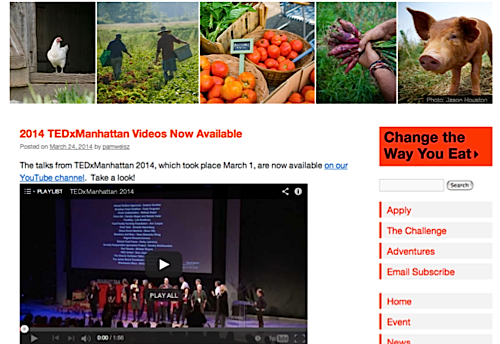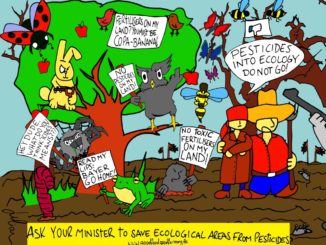
Every now and then there are opportunities to find out what other sections of the food movement are saying and doing. At the beginning of March, there was a kaleidoscopic gathering of the US food movement in Manhattan that recorded its speakers and has made the videos available on the web.
TEDx Manhattan sets out to change the way we eat. The speakers delivered short presentations like a smooth running carousel. This could be hard to follow at times, but the event reflected the diversity of the US food movement sympathetically.
Thanks to the Sustainable Food Trust and the efforts of food activist Justyna Kolowrotna, a group viewing for the live web-event gathered in London. For those who missed the presentations first time around, they can be viewed and downloaded at livestream.com. The video files are a tad heavy on bandwidth at between 90MB and 120MB for each speaker, but this is worthwhile for topics that are relevant to your organisation’s work.
“I was inspired by the passion which was boldly reflected by the TEDxManhattan speakers and organizers of the conference,” Kolowrotna told ARC2020. “We were provided with vital and fundamental facts from the use and effect of antibiotics in our supposedly ‘cheap’ food system by Andrew Gunther. We heard about the treatment of the people who handle our food from Saru Jayaraman, a co-founder and co-director, Restaurant Opportunities Centers United (ROC United) and then how our diet and life expectancy are often linked to our postcode from Clint Smith, an educator at Parkdale High School.”
Justyna is already looking forward to 2015: “It was a great event and for next year’s viewing party, I feel encouraged to make some super sustainable and protein-packed cricket flour cookies. Blame it on Megan Miller!”
Head of communications at the Sustainable Food Trust, Aine Morris, told ARC2020: “The Sustainable Food Trust was pleased to have the opportunity to bring the messages of TEDxManhattan to a UK audience. The American food movement has made real strides in recent years to move away from simply celebrating good food towards a more political movement, with values of social justice, food democracy and relocalised food systems at the heart of all they do.”
A key challenge for any food campaign is to get its message further afield, to speak to those outside its immediate constituency. “Through hosting a TEDx viewing party, we were able to bring these important ideas to those in the UK who are working towards a better food future for all. The quality and range of topics covered were an inspiration and we thoroughly look forward to hosting similar events in the future.”
Every speaker came with a message, delivered with commitment and sometimes deeply personal. Matt Moore, a fourth generation farmer, faces the prospect of being the final farming generation in his family, as the tentacles of surburbia tighten their grip on his holding. He has devised original ways of documenting this transition that speak to anyone willing to see and listen.
At the city dweller end of the access to land spectrum, Regina Bernard-Carreno recounts her struggle to make headway with food-growing groups in New York. The social challenges she faces with courage and candour run deeper than any technical constraints. Her account of touring well-intentioned but gentrified growing projects with a group of students from deprived backgrounds is an object lesson for the food movement. It is essential to be inclusive and outward looking from the outset.
Alison Cayne’s account of an obsession with the origins of broccoli leads to insight into the timescales and developmental stages of social movements. She seamlessly links kitchen table curiosity to a movement that stands alongside votes for women and the civil rights movement.
Speaking back to back with Andrew Gunther, Dr Lance Price revisits the vexed topic of antibiotics in farm animals from scientific perspective. In the process, he reminded his audience that the term ‘superbug’ is far too cosy: “…it’s just a cute word we use for antibiotic-resistant bacteria…” that are fatal for 23,000 US citizens every year. Farm animals are dosed with 13.6 million kilos of antibiotics every year, often at prophylactic levels. Around 20% is going to sick animals. The rest is being used to treat what Price chillingly refers to as “production diseases”. Rather than make production healthy, he warns, it is more profitable to buy in antibiotics and dose up the sheds. So the system is broken but if we act now we might still be able to fix it. But only if we act now.





